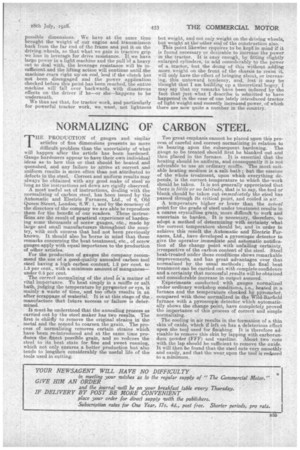NORMALIZING OF CARBON STEEL.
Page 13

If you've noticed an error in this article please click here to report it so we can fix it.
THE PRODUCTION of gauges and similar articles of fine .dimensions presents no more difficult problem than the uncertainty of what will happen after the article has been hardened. Gaege hardeners appear to have their own. individual ideas as to how this or that should be heated and quenched, and any failure to arrive at correct and uniform results is more often than not attributed to defects in the steel. Correct and uniform results may always be obtained with any good make of steelso long as the instructions set down are rigidly observed. A most useful set of instructions, dealing with the normalizing of carbon steel, has been issued by the Automatic and Electa:ic Furnaces, Ltd., of 6, Old Queen Street, London, S.W. 1, and by the courtesy of the directors of the company we are able to reproduce them for the benefit of our readers. These instrucfleas are the result of practical experience of hardening some thousands of screw gauges, etc.' -made by large and small manufacturers throughout the country, with such success that had not been previously known. It should alsobe 'borne in mind that these remarks concerning the heat treatment, etc., of screw gauges apply with equal importance to the production of other articles.
For the production of gauges the company recommend the use of a good-qUality annealed carbon tool steel having a high carbon content, 1.2 per cent. to 1.5 per cent., with a minimum amount of manganese— under -0.5 per cent. The correct normalizing of the steel Is`a matter of vital importance. To heat simply in a muffle or salt bath, judging the temperature by pyrimeter or eye, is mainly a waste of time, and too often results in an after acrappage of material. It is at this stage of themanufacture that fature -success or failure is determined.
It must be understood that the annealing process as carried out by the steel maker haa two results. The first is chiefly to _remove the original strains in the , metal and the second to coarsen the grain.. The process of normalizing removes certain strains which have been re-introduced and at the same time produce a the finest possible grain, and so reduces the steel to its best state for fine and sweet running, which not only ensures a better production but also tends to lengthen considerably the useful life of the tools used in cutting.
Too great emphasis cannot be placed upon this proeess of careful and correct normalizing in relation to its bearing upon the subsequent hardening. The gauge to be treated should first be blanked out and then placed in the furnace. It is essential that the heating should be uniform, and consequently it is not advisable to use an ordinary muffle. The most suitable beating medium is a salt bath but the essence of the whole treatment, upon which everything depends, is the correct temperature to which the-work should be taken. It is not generally appreciated that there is little or no latitude,. that is to say, the tool or blank, should be taken out trarnediately the steel has passed through its critical point, and cooled in air.
A temperature higher or lower than the actual point for the grade of steel under treatment results in a coarse crystalline grain, more difficult to work and uncertain to harden. It is necessary, therefore, to adopt a method of determining with certainty what the correct temperature should be, and in order to achieve this result the Automatic and Electric Furnaces, Ltd., have developed a _pyroscopic detector to give the operator immediate and automatic notification of the change point with unfailing certainty, irrespective of the carbon content of the steel. Steel heat-treated under these conditions shows remarkable improvements, and has great advantages over that normalized by the usual methods; the final heat treatment can be carried out with complete confidence and a certainty that successful results. will be obtained and considerable increase in output assured.
Experiments conducted with gauges normalized under ordinary workshop eonditions, i.e., heated in a furnace and the temperature checked by pyrometer, compared with those normalized in the Wild-Barfield furnace with a pyroscopic. detector which automatically showa the change point, have completely proved the importance of this process of correct and simple normalizing.
The cooling in air results in the formation of a thin skin of oxide, which if left on has. a deleterious effect upon the teal used for finiahing. It is therefore advisable to remove this skin by lapping with carborundum. powder (FFF) and vaseline. About two runs with the lap should be sufficient to remove the oxide. It will then he found that the steel cuts very smoothly and easily, and that the wear, upon the tool is reclaiced to a minimum.






















